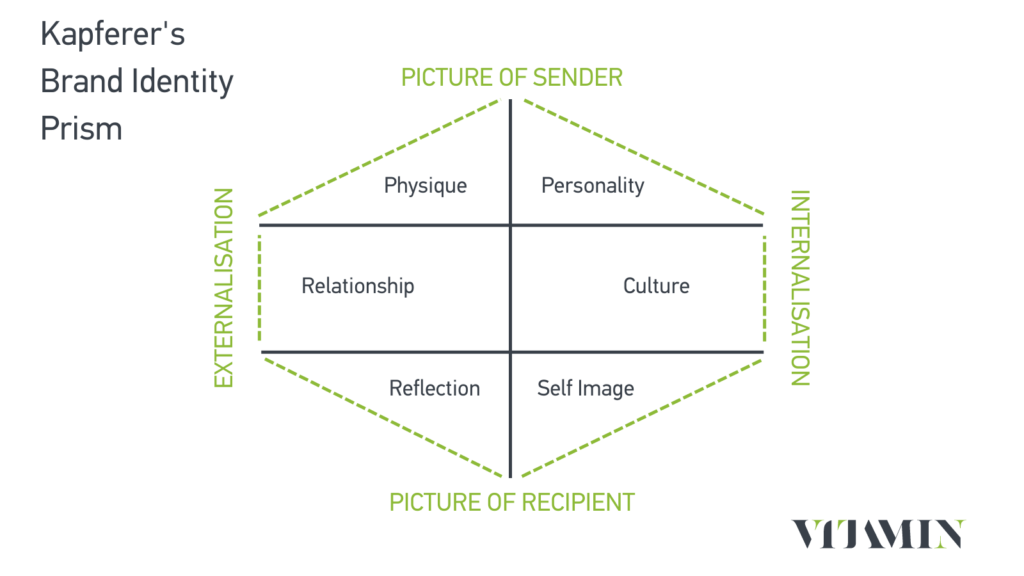A robust and unique brand identity can go a long way toward distinguishing your brand from the competition.
In this article, we will explore what brand identity is, why it is so important, and how to create one using Kapferer’s Brand Identity Prism.
What is Brand Identity?
Brand Identity is far more than just a logo or a product. It is more concerned with the impression and impact you make on people and the unique brand features that separate you from the competition.
Brand Identity goes far beyond branding.
Your brand’s tone of voice on social media, the way your employees talk about your company, and the work your company does in the community – are all examples of what can be considered an aspect of your brand’s identity.
The following all contribute to the formation of a brand’s identity, but this is not an exhaustive list; anything that your company does or that can be considered representative of your company can have an impact on brand identity. The following are just some examples:
- Logo
- Typography
- Company Values
- Employee Advocacy
- Tagline
- Colour Palette
- Tone of Voice
- Value Proposition
- Packaging
Why Does Brand Identity Matter?
Your brand identity has the power to set you apart from the crowd in a significant way. The power of your brand to influence the perception of your product and raise it to something more cannot be underestimated.
“Brand identity fuels recognition, amplifies differentiation, and makes big ideas and meaning accessible.”
– Alina Wheeler, Author of Designing Brand Identity.
The proof is in the pudding though! Here are some examples of how real-life companies have benefited from having a well-crafted brand identity:
Increasing Brand Recognition
If your brand has a well-defined, memorable identity people will retain information about it and it will become instantly recognisable. Take, for example, Nintendo. You may not necessarily play video games but you most likely recognise the brand!
That’s because Nintendo has worked hard to build a compelling, fun, family-friendly brand identity that is rooted in innovation. A Nintendo game or console has a distinctive feel to it and they have established a collection of IP that is complimentary of the brand’s identity, and instantly recognisable.
Increasing Brand Loyalty
A good brand identity can help to build customer loyalty and trust in a brand as it enables a customer to form a connection between a product and a company. A strong brand will build a loyal following by returning continuously positive experiences to the customer.
Nike, for example, is not only one of the world’s most recognisable brands but also has one of the most loyal customer bases. According to Marketing Week, almost 70% of Nike’s digital sales are from repeat customers.
This success may have been difficult to achieve if not for the shoe giant’s formidable brand identity. The familiar swoosh logo and the “just do it” slogan, along with its use of celebrity endorsements, are excellent indicators of its mission – “to bring innovation and inspiration to every athlete in the world”.
Establishing Brand Differentiation
The process and outcome of demonstrating to the world how your company differs from the competition is known as brand differentiation. One of the most effective ways to achieve brand differentiation is by creating a unique and memorable brand identity that resonates with your audience.
A recent example of this in action is the dating platform, Thursday. In a crowded market with the likes of Tinder and Bumble, Thursday has used its unique identity to separate itself from the pack and position itself as an interesting alternative with a clear differentiator.
The app, in solidarity with its name, only operates on Thursdays and pushes the envelope with its creative marketing campaigns, positioning itself in its own, uncontested market space.
Increasing Hiring Opportunities
Another advantage of a great brand identity is the hiring power it provides. People often aim to have a long list of reputable companies on their CV e.g. Google, Salesforce, etc. And, with a broader application pool, you’ll have a better chance of finding people that are a good fit for your organization.
Candidates will be more interested in working with your firm if your brand is reputable and recognisable, as opposed to others. A 2021 survey by Glassdoor revealed that 68% of millennials visit a prospective employer’s social media channels to assess their brand before applying.
A company’s brand strategy should include the formation of a comprehensive brand identity. It is, however, critical to conduct proper research before developing a brand identity, as the choices you make here will define your brand for a long time. We recommend using Kapferer’s Brand Identity Prism.
The Brand Identity Prism
Jean-Noel Kapferer is a well-revered brand specialist around the world. He is known for his groundbreaking work in areas such as Brand Identity, Strategic Brand Management, Brand Structuring, and more.
In 1996, he devised the Brand Identity Prism – a framework containing what he considered to be the 6 most important features of Brand Identity.
- Physique
- Personality
- Culture
- Relationship
- Self-Image
- Reflection
Kapferer uses a diagram to show the interaction between each element. Physique, Personality, and Culture are all said to represent the company, with the latter three representing the consumer. We’ll take a look at each element in detail, and provide examples of brands that have crafted and maintained the perfect brand identity.

Physique
The physical qualities of a brand are the first factor. Specifically, how we establish the brand and how it will materialise, including visual features that assist consumers in recognising the brand.
Often when we think about branding, we think about what we can see – a logo, a website, a colour, or a font. We think about the likes of Coca-Cola and the soft-drink brand’s distinctive Coke Red, that white, flowing font, and the company’s uniquely shaped contour bottle.
Personality
As the name implies, this element is all about a brand’s character. It concerns how a brand communicates with the outside world – through the likes of its tone of voice, copywriting, and design.
Apple, for instance, has nailed its brand personality. Portraying itself as both sophisticated and creative, Apple customers know exactly what to expect from the brand and are incredibly loyal and passionate as a result. The tech giant further commits to its brand personality with each innovation or product update, and goes from strength to strength as a result – Apple ranked third in the 2022 Fortune 500 Rankings.
Culture
The value system and ideas on which a brand bases its behaviour are referred to as culture in Kapferer’s Prism.
In the case of Starbucks, the coffeehouse chain has established a distinct brand culture that even emanates from its stores. Each store is designed with the brand’s desire to build a warm, welcoming culture in mind. It ensures to create a friendly atmosphere and comfortable ambience that inspires human connection.
Relationship
In the relationship section of the Brand Identity Prism, the nature of the relationship between the brand and its consumers is addressed, which covers both abstract and more concrete elements such as specific services offered. It is entirely up to the brand to engage with its target audience and form the kind of relationship it seeks.
Uber is currently building strong relationships by meeting its customers where they are – and not just in the literal sense. By offering the likes of pet-friendly rides, quiet rides, eco-friendly rides, in-car credit payments, and vehicle tracking, the lift-sharing company is addressing the exact needs of its customers, generating goodwill in the process.
Self-Image
According to Kapferer, customers’ ideal selves are visualised through self-image. Understanding this empowers businesses to better serve their clients. Consider how your services and interactions will be of benefit to them.
Consider the likes of Gillette or Old Spice, and how they project their brands on customers. If you believe yourself to be a well-kept man who always tries to look their best, you may be naturally drawn to a brand such as Gillette. Old Spice identifies with those who picture themselves as the traditional “perfect man”. This is a sentiment that is made evident by its famous “The Man Your Man Could Smell Like” advertisements, which attempt to appeal to its target audience’s self-image by addressing the women in their lives.
Reflection
The final section of the Prism concerns Reflection. While it is similar to Self-Image, Reflection refers to how a brand perceives its customers.
It is frequently described as stereotypical characteristics regarding a brand’s customer base. This element of the Prism is often used for promotional purposes. For example, if you drink the Irish brand of beer and cider, Rockshore, you are depicted in its advertising campaigns as being fun, adventurous, and carefree.
Getting your brand identity right is the key to unlocking its full potential.
Now that you’ve read this article on Brand Identity, why not check out our other articles for more web development, graphic design, and digital marketing insights?
Do you need help with your brand’s identity? Contact us today to get your project started!


